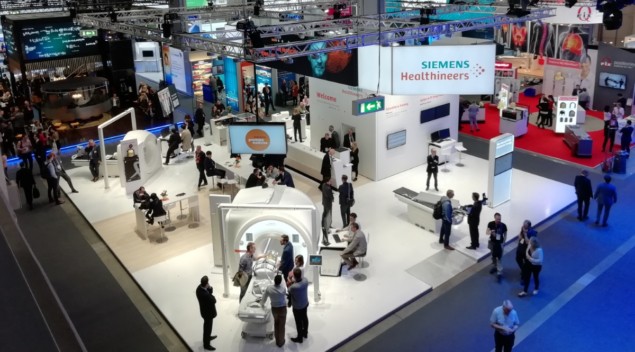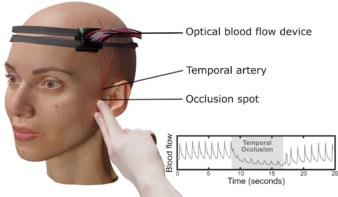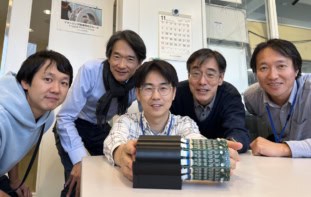
There’s always plenty to catch the eye at an ESTRO trade show, from companies displaying full-scale treatment systems — often accessorized with real-life models posing as patients — to the myriad of smaller vendors showcasing their latest radiotherapy and oncology innovations. RaySearch’s booth always draws one’s attention, with its slick wood floors and illuminated equations, as does Accuray’s dancing CyberKnife.
A stroll around the show floor revealed that this year’s exhibition was no exception, with 100 or so companies vying for the attention of over 6000 delegates attending ESTRO 38 in Milan.
Accuray took the robotic display theme a step further this year with two “dancing” video screens — there to promote the launch of Synchrony motion tracking technology for its Radixact radiotherapy system. “We are the only company that can do real-time tracking, detection and correction of motion during treatment delivery,” Accuray’s Andrea Cox told me. “CyberKnife has been doing this for 15 years, now we’ve added it to Radixact.”
Synchrony works by taking 2D kilovoltage images during treatment delivery, recording 2–6 images per rotation, and using these to locate the target. It then corrects for target motion and synchronizes beam delivery to the moving tumour’s location in real time.

For prostate treatments, for example, motion is corrected for using Radixact’s dynamic collimation system. For lung cancer cases, meanwhile, images are correlated with the patient’s breathing phase to create a predictive model of respiratory motion. As this approach does not require gating, this makes treatment delivery highly efficient. Cox notes that Synchrony is 510k FDA cleared, and the company expects the first clinical installation in the next few months.
Elsewhere, Dosisoft was displaying its software for quality assurance of external-beam radiotherapy and dosimetry of internal radiotherapy using radionuclides. CEO Marc Uszynski explained that while treatment planning systems are evolving to offer higher levels of sophistication and individualization in external-beam treatments, it’s often a case of “one size fits all” when it comes to internal radiotherapy.
PLANET Dose, the company’s treatment planning system for internal radiotherapy, aims to change this by introducing patient-specific treatment planning and in vivo control. Initially designed for targeted radionuclide therapy with yttrium-90, ESTRO saw Dosisoft launch of PLANET Dose for 177-lutetium targeted therapy — the first such offering on the market, Uszynski told me.
Another product on display was the new Xstrahl 150 system, billed as “the company’s most comprehensive superficial system dedicated to skin cancer treatments”. The system offers several features that enhance Xstrahl’s current 150 kV offering, including ion chamber-based integrated dosimetry, the ability of use with different applicators and increased manoeuvrability.
One theme permeating this year’s ESTRO conference was the introduction of artificial intelligence into radiation oncology. And this was echoed on the show floor. For example, Philips was showcasing the work-in-progress MRCAT brain, an extension of its MR-only radiotherapy simulation portfolio. Designed for brain radiotherapy, the system creates “CT-like” images from MR scans, using artificial intelligence trained to convert MR into CT data.
MRCAT takes a single high-resolution mDIXON MRI scan and, in just a few minutes, uses this to generate the electron density information that MRI cannot. The resulting CT-like image is used to perform dose calculations for treatment planning. The idea is to allow clinicians to employ a single imaging modality to provide MR images with high soft-tissue contrast for delineation, plus density information for dose calculations.
There were a few new features at the trade show this year. ESTRO 38 introduced “The Stage”, dedicated to industry pitches and meet-and-greets, as well as providing space for delegates to rest their weary feet. There was also a “Selfie Corner”, plus a spinning wheel that allowed attendees to determine their “wishes and dreams in the field of radiation oncology”.
Finally, the “Start-Up Corner” provided a dedicated area for start-up companies to present their new concepts and products. There were some highly novel ideas on show among the start-ups, and I’ll be publishing a dedicated report looking at some of these later this week. And keep an eye out for coverage of the ESTRO conference — including reports on innovative technologies and some lively debates.



